Notes: Materials of Daily Use | Science & Pedagogy Paper 2 for CTET & TET Exams - CTET & State TET PDF Download
Introduction
The advancement of chemistry as a discipline has given us a wide variety of materials that are essential for our daily lives. Acids, bases, and salts are fundamental in the production of these materials. For instance, they are used in making soaps, polymers, and cements. These products have not only made life easier for people but have also significantly improved our quality of life.
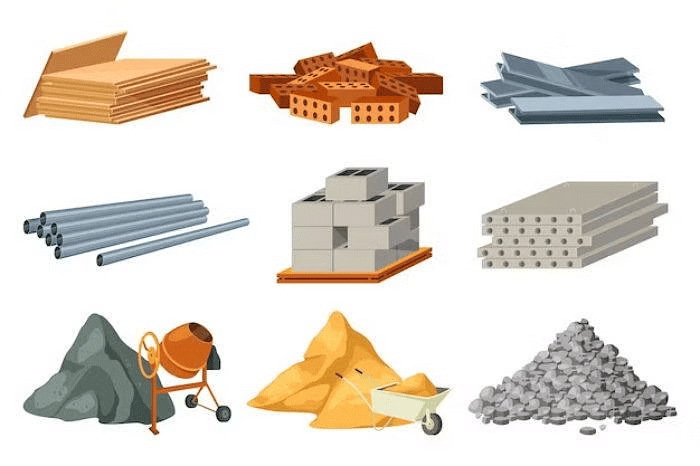
Acids
Acids are substances that taste sour and can change blue litmus paper to red. When dissolved in water, they produce hydrogen ions(H +). There are two main types of acids: organic acids, which come from living sources, and mineral acids, which come from non-living sources.
Properties of Acids
- Acids can conduct electricity.
- When acids react with active metals, they produce hydrogen gas.
- Acids react with metal carbonates and bicarbonates to produce carbon dioxide gas.
- Acids react with bases to form salts and water in a process called neutralization.
- Acids have a corrosive nature.
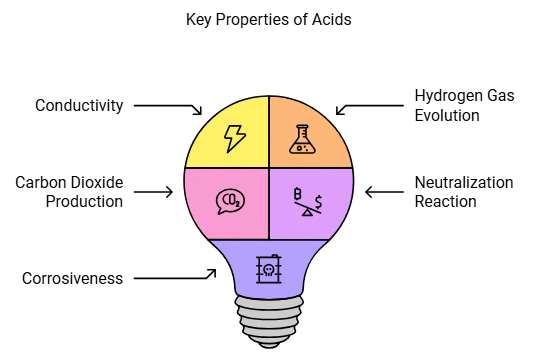
Classification of Acids
Class I: Based on Degree of Dissociation- Strong Acids:These acids dissociate completely, even in concentrated solutions. Examples include:
- Hydrochloric Acid (HCl)
- Nitric Acid (HNO3)
- Sulfuric Acid (H2SO4)
- Perchloric Acid (HClO4)
- Weak Acids:These acids only partially dissociate when dissolved in water. Examples include:
- Acetic Acid (CH3COOH)
- Formic Acid (HCOOH)
Class II: Based on Presence of Oxygen or Hydrogen
- Hydracids:These acids do not contain oxygen. Examples include:
- Hydrochloric Acid (HCl)
- Hydrofluoric Acid (HF)
- Oxyacids:These acids contain both oxygen and hydrogen. Examples include:
- Sulfuric Acid (H2SO4)
- Nitric Acid (HNO3)
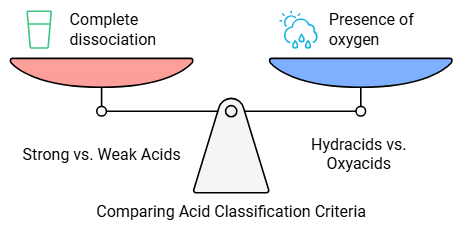
Sources and Uses of Some Important Acids
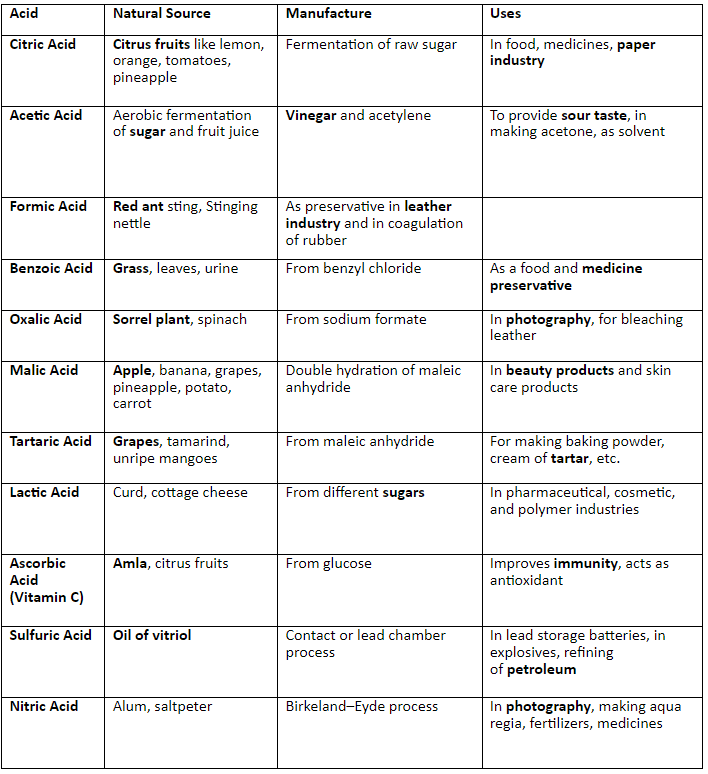
Acid Burns
When making dilute solutions of acids (like H2SO4, HCl, HNO3), it's very important to add the acid to water slowly while stirring continuously. If you add water to acid, it can generate a lot of heat very quickly. This heat can cause the glass container to break, leading to serious acid burns if the hot mixture splashes onto your clothes or skin.
Aqua-regia:
- Aqua-regia is a mixture of hydrochloric acid and nitric acid in a ratio of 1:3.
- It is a powerful chemical reagent capable of dissolving even noble metals like gold and platinum.
Acid Rain:
- Rain that contains an excess of acids such as carbonic acid, sulfuric acid, and nitric acid is termed acid rain.
- This phenomenon occurs when CO2, SO2, and NO2 dissolve in raindrops.
- Acid rain causes severe environmental pollution, damaging animal skins, plants and crops, and eroding buildings and bridges.
Acid-Containing Biomolecules:
- Important biomolecules in living systems are acids.
- DNA and RNA are nucleic acids, while proteins and fats consist of amino acids and fatty acids, respectively.
Bases
- Bases are substances that have a bitter taste, a soapy feel, and can turn red litmus paper blue.
- When bases dissolve in water, they produce hydroxyl ions (OH-).
- However, not all bases have a bitter taste. Those bases that do dissolve in water are specifically called alkalies.
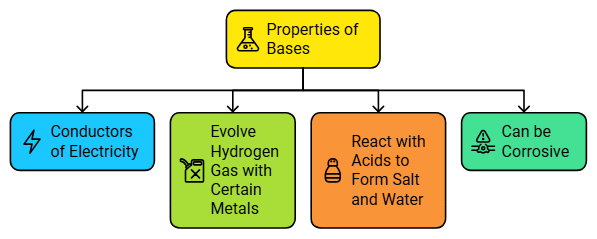
Properties of Bases
- Conductors of Electricity: Bases are capable of conducting electricity.
- Reactivity with Metals: Bases produce hydrogen gas when they react with certain metals.
- Neutralization Reaction: Bases react with acids to form salt and water.
- Corrosive Nature: Some bases can be corrosive.
Sources and Uses of Some Important Bases
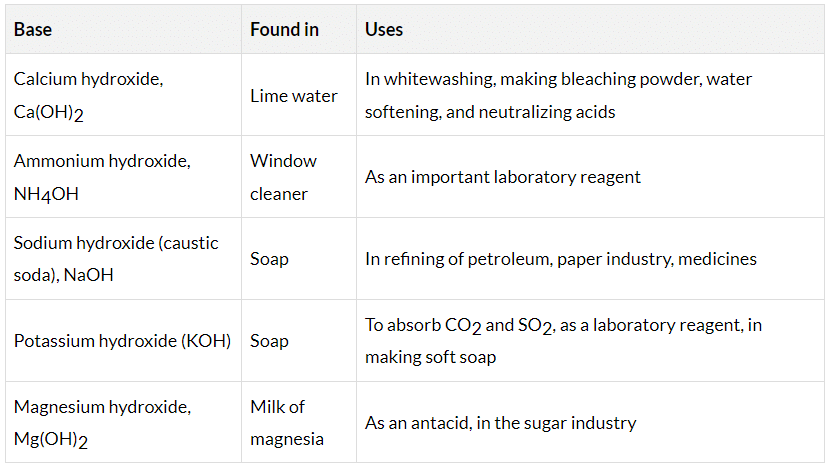
Lewis Acids and Bases
According to the Lewis concept, a base is defined as a species that donates a pair of electrons to form a coordinate bond, while an acid is one that accepts this electron pair.
Lewis acids are typically electron-deficient species, also known as electrophiles. Examples include AlCl3, Co2+, and Mg2+. On the other hand, Lewis bases are electron-rich species, or nucleophiles, such as H2O, NH3, OH-, NO, and CO-.
Limitations of Lewis Concept
- The strength of Lewis acids and bases varies depending on the type of reaction, making it impossible to arrange them in a consistent order of relative strength.
- The Lewis concept fails to explain the behavior of protonic acids like HNO3, HCl, and H2SO4.
- Many acids act as catalysts because of their ability to release H+ ions, a characteristic that Lewis acids do not possess.

Soaps:
- Soaps are made from natural fats and oils through a process called saponification. In this process, fats or oils are reacted with sodium hydroxide, which is a type of strong base. This reaction produces soap and glycerol.
- Soap molecules have two different ends: one end is hydrophobic, meaning it repels water, and the other end is hydrophilic, meaning it attracts water. This unique structure allows soap to effectively clean by grabbing onto grease and dirt, which are then washed away with water.
Detergents:
- Detergents are similar to soaps in that they also have hydrophobic and hydrophilic ends. However, detergents are made from petroleum hydrocarbons, which makes them different from natural soaps.
- One of the advantages of detergents is that they work well in both soft and hard water. This is because hard water contains minerals that can interfere with the cleaning power of some soaps, but detergents are designed to be effective regardless of the water quality.
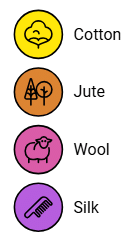
Natural Fibres
- Natural fibres are derived from plants or animals.
(a) Cotton:
- Cotton is sourced from cotton plants that thrive in regions with black soil and a warm climate, such as Gujarat.
- The primary component of cotton fibres is cellulose.
(b) Jute:
- Jute fibres are obtained from the stem of jute plants, which are cultivated in states like Bihar, West Bengal, and Assam.
- The fibres are separated from the stems by soaking them in water.
(c) Wool:
- Wool is derived from animals such as sheep, goats, and yaks.
- The process of obtaining wool involves shearing the fleece from the animals, followed by washing and sorting the fleece.
- Wool is classified as a protein fibre.
(d) Silk:
- Silk is produced by silkworms through a process known as sericulture.
- The silk fibres are extracted from the cocoons of silkworms and are used in the production of textiles.
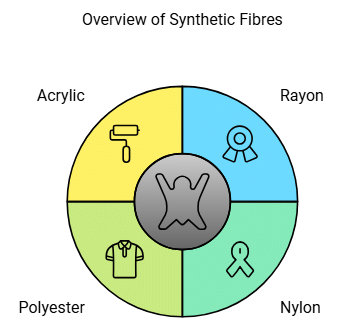
Synthetic Fibres
- Rayon: Rayon is a synthetic fibre made from natural cellulose through chemical processes. It has a smooth, silky look and is often blended with other fibres like cotton and wool to enhance the fabric's qualities.
- Nylon: Nylon was the first fully synthetic fibre, created from basic materials like coal, water, and air. It is known for its strength and heat resistance, making it suitable for a wide range of applications, from clothing to industrial products.
- Polyester: Polyester is made from ester units and is known for its durability and resistance to wrinkles. It is widely used in textiles and is also a common material for making PET bottles.
- Acrylic: Acrylic fibres mimic the qualities of wool and are commonly used in products like sweaters and blankets. They are more affordable than wool and come in a variety of colors.
Testing of Fibres

Plastics
Plastics are a type of polymer with different arrangements. They are classified into:
- Thermoplastic. These plastics soften when heated and can be reshaped. Examples include polythene, polystyrene, and PVC.
- Thermosetting. These plastics do not soften when heated. They retain their shape permanently due to a process called cross-linking. Examples include bakelite and melamine.
Properties of Plastics:
- Plastics are non-reactive and corrosion-resistant.
- They are lightweight, strong, and durable.
- Plastics are poor conductors of electricity and heat.
- However, they are environmentally hazardous and contribute to pollution.
Important Types of Plastics:
- Polythene. This plastic is chemically inactive, water-resistant, tough, flexible, and strong. It can be molded into various shapes.
- Polyvinyl Chloride (PVC). PVC is tougher than polythene and is a good insulator.
- Polystyrene. This plastic is very light, easily blown, and more moldable than polythene.
- Perspex. Perspex is extremely tough, lightweight, very transparent, and has high optical clarity.
- Teflon. Teflon is very tough, resistant to acids and bases, and is a poor conductor of heat. It is also known as one of the best plastics.
- Bakelite. Bakelite is hard and strong, fire-resistant, but becomes brittle when exposed to excessive heat.
- Melamine. Melamine is versatile, fire-resistant, and can tolerate heat better than many other plastics.
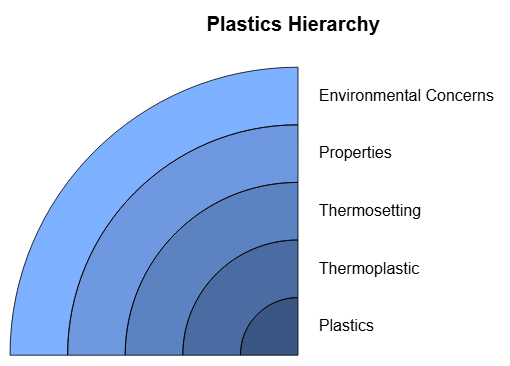
Plastics and Environmental Issues
- Plastics, such as polythene bags, are challenging to dispose of because they can take hundreds of years to decompose.
- When plastics are burned, they release toxic fumes, which is harmful to the environment.
- Animals can experience severe health problems if they ingest plastic materials.
- Therefore, it is crucial to find biodegradable alternatives to plastics, such as materials made from vegetables, paper, wood, and cotton fabrics.
- Biodegradable materials can be broken down by microorganisms like bacteria.
- In contrast, non-biodegradable materials, including plastics and non-metal substances, cannot be decomposed by such microorganisms.
Bleaching Agents
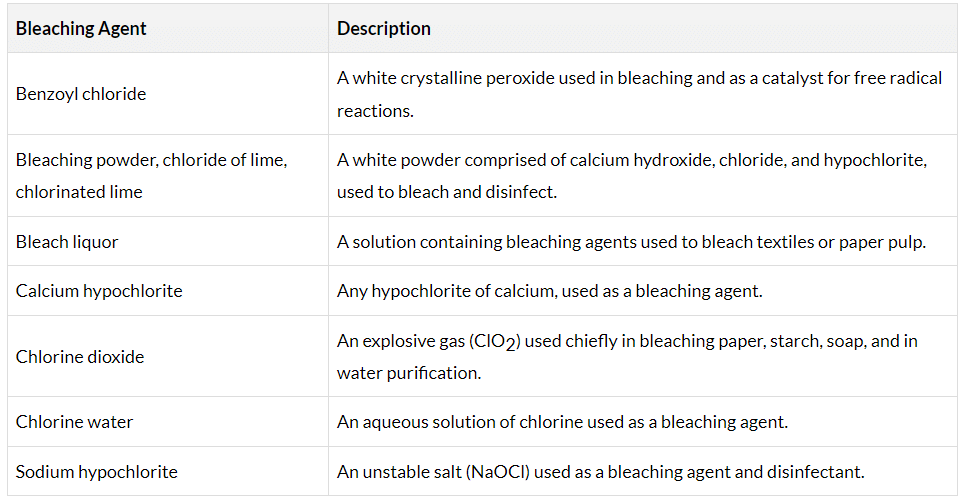
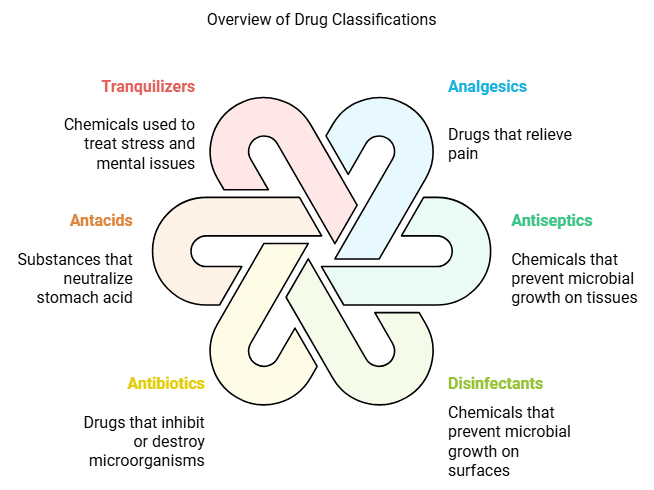
Drugs
Drugs are chemical substances that have an impact on human metabolism and are used to cure various ailments. They are classified based on their therapeutic actions.
- Analgesics: These drugs provide relief from pain. Examples include Morphine, Heroin, and Aspirin.
- Antiseptics: Antiseptics are chemicals that inhibit the growth of microorganisms without harming human tissues. Examples include Dettol, Bithinol, and Tincture of Iodine.
- Disinfectants: Disinfectants prevent the growth of microorganisms on inanimate objects. Examples include Phenol solution and chlorine in aqueous solution.
- Antibiotics: Antibiotics inhibit the growth or destroy microorganisms by interfering with their metabolic processes. An example is Penicillin.
- Antacids: Antacids neutralize excess stomach acid. Examples include Sodium hydrogen carbonate and Aluminium and Magnesium hydroxide.
- Tranquilizers: Tranquilizers, also known as anti-depressant drugs, are used to treat stress and mental problems. Examples include Equanil, Serotonin, and Chlorodiazepoxide.
There are many other important classes of drugs based on their action, such as anti-histamines, anti-microbials, anti-fertility drugs, and antipyretics.
|
35 videos|146 docs|32 tests
|
FAQs on Notes: Materials of Daily Use - Science & Pedagogy Paper 2 for CTET & TET Exams - CTET & State TET
| 1. What are the common properties of acids? |  |
| 2. How are acids classified? |  |
| 3. What are some important sources and uses of common acids? |  |
| 4. What is acid rain, and what are its effects? |  |
| 5. How can acid burns be treated effectively? |  |

















